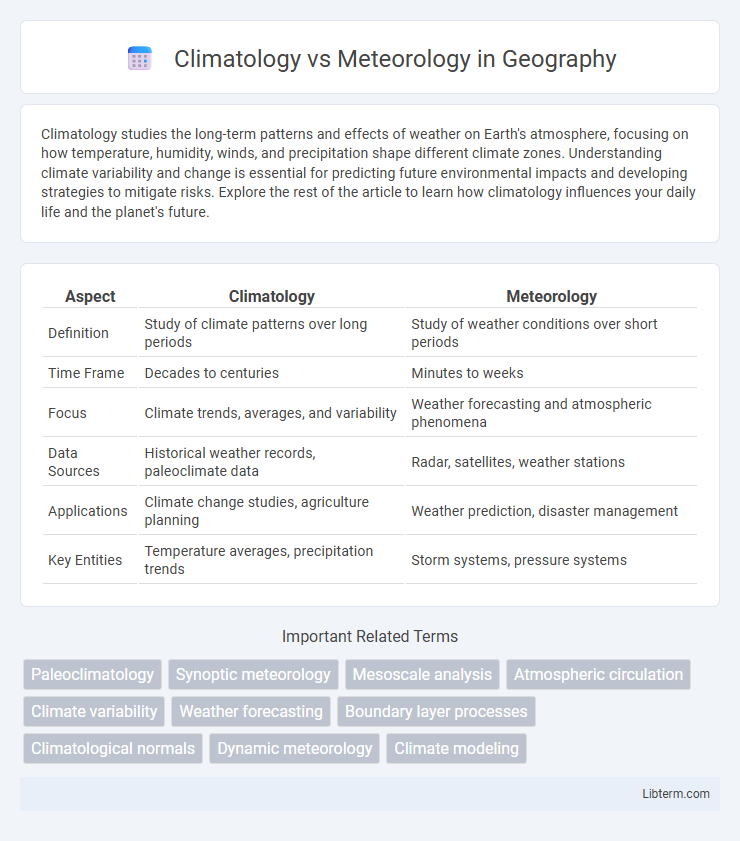Climatology studies the long-term patterns and effects of weather on Earth's atmosphere, focusing on how temperature, humidity, winds, and precipitation shape different climate zones. Understanding climate variability and change is essential for predicting future environmental impacts and developing strategies to mitigate risks. Explore the rest of the article to learn how climatology influences your daily life and the planet's future.
Table of Comparison
| Aspect | Climatology | Meteorology |
|---|---|---|
| Definition | Study of climate patterns over long periods | Study of weather conditions over short periods |
| Time Frame | Decades to centuries | Minutes to weeks |
| Focus | Climate trends, averages, and variability | Weather forecasting and atmospheric phenomena |
| Data Sources | Historical weather records, paleoclimate data | Radar, satellites, weather stations |
| Applications | Climate change studies, agriculture planning | Weather prediction, disaster management |
| Key Entities | Temperature averages, precipitation trends | Storm systems, pressure systems |
Introduction to Climatology and Meteorology
Climatology studies long-term atmospheric patterns and trends to understand Earth's climate system, using data spanning decades to millennia. Meteorology focuses on short-term weather phenomena and atmospheric conditions, providing forecasts based on real-time observations and models. Both fields rely on atmospheric sciences but differ in temporal scale and data scope, with climatology analyzing historical climate variability and meteorology emphasizing immediate weather prediction.
Defining Climatology: Scope and Focus
Climatology studies long-term atmospheric patterns and trends over extended periods, typically decades to centuries, analyzing data related to temperature, precipitation, and climate variability. It focuses on understanding the Earth's climate system, including factors influencing climate change, such as greenhouse gas concentrations and solar radiation. Unlike meteorology, which concentrates on short-term weather forecasts and atmospheric processes, climatology provides insights into historical climate behavior and future climate projections.
Meteorology: Key Concepts and Applications
Meteorology studies atmospheric conditions and weather processes, analyzing elements such as temperature, humidity, wind patterns, and precipitation to predict short-term weather events. Utilizing radar, satellites, and weather models, meteorologists provide accurate forecasts critical for agriculture, aviation, disaster management, and daily decision-making. Advanced techniques in meteorology also support climate trend analysis and help mitigate the impact of extreme weather phenomena like hurricanes and tornadoes.
Core Differences Between Climatology and Meteorology
Climatology studies long-term atmospheric patterns and trends over decades to centuries, analyzing data such as temperature averages, precipitation rates, and climate variability. Meteorology focuses on short-term weather phenomena, providing hourly to weekly forecasts based on atmospheric pressure, humidity, wind, and temperature changes. Core differences include temporal scale--climatology emphasizes long-term climate shifts, while meteorology targets immediate weather conditions--and scope, with climatology addressing global and regional climate systems and meteorology concentrating on localized weather events.
Research Methods in Climatology vs Meteorology
Research methods in climatology predominantly analyze long-term atmospheric data through statistical modeling, paleoclimate reconstructions, and climate simulation models to understand trends and variability over decades to millennia. In contrast, meteorology focuses on short-term weather prediction using real-time data assimilation, numerical weather prediction models, and remote sensing technologies to forecast conditions over hours to weeks. Climatology relies on large datasets and pattern recognition for climate change assessment, while meteorology emphasizes dynamic atmospheric processes and event forecasting.
Time Scales: Short-Term Weather vs Long-Term Climate
Meteorology studies short-term atmospheric phenomena, analyzing weather patterns over hours to weeks to provide forecasts and warnings. Climatology focuses on long-term trends and averages of weather variables, examining data over decades to centuries to understand climate variability and change. Understanding the distinction in time scales helps in applying appropriate models for weather prediction and climate projections.
Tools and Technologies Used in Both Fields
Climatology utilizes long-term data collection tools such as satellite remote sensing, climate models, and paleoclimatic proxies like ice cores and tree rings to analyze historical climate patterns and predict future trends. Meteorology relies heavily on real-time observational instruments including weather radars, Doppler radar systems, weather balloons, and automated weather stations to provide short-term weather forecasts and track atmospheric phenomena. Both fields integrate advanced computational techniques and geographic information systems (GIS) to enhance the accuracy of environmental data analysis and forecasting.
Practical Applications in Society
Climatology provides essential insights for long-term urban planning, guiding infrastructure development to withstand future climate changes and extreme weather patterns. Meteorology supplies critical real-time weather forecasts used in agriculture, aviation, and disaster management to mitigate risks and enhance public safety. Together, these sciences support efficient resource management and emergency preparedness, ensuring communities adapt to both immediate weather events and evolving climatic trends.
Career Paths: Climatologist vs Meteorologist
Climatologists analyze long-term weather patterns and climate changes to understand global and regional climate trends, working in research institutions, environmental agencies, and policy development. Meteorologists focus on short-term weather forecasting and atmospheric phenomena, often employed by weather services, media outlets, and aviation sectors. Both careers require strong backgrounds in atmospheric sciences, but climatologists prioritize data modeling and climate impact studies, whereas meteorologists emphasize real-time weather prediction and hazard warnings.
Future Trends in Climate and Weather Science
Advancements in climatology and meteorology increasingly rely on artificial intelligence and machine learning to enhance predictive models for long-term climate patterns and short-term weather events. High-resolution satellite data and improved computational power enable more accurate simulations of extreme weather occurrences and the impact of climate change on regional ecosystems. Collaborative global monitoring systems contribute to refining early warning systems, reducing natural disaster risks, and informing sustainable environmental policies.
Climatology Infographic

 libterm.com
libterm.com